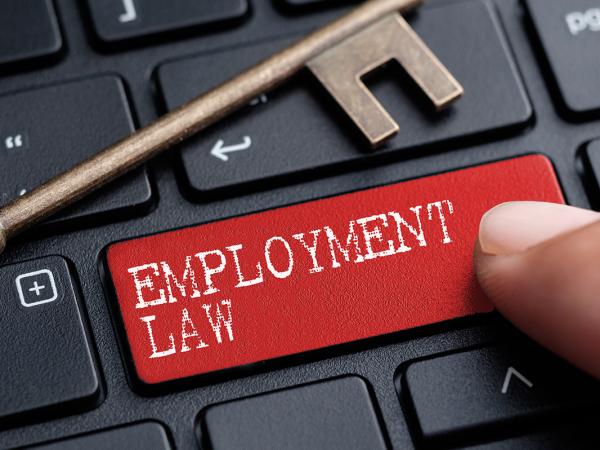Employee leaving
This page covers what to do when an employee leaves your employment, including giving them a P45. For guidance on things to think about if you need to dismiss an employee, or if your employee resigns, see our employment law section.

Content on this page:
Form P45
When your employee leaves, you need to give them a P45. The P45 is an important document as it is the way in which pay and deduction details are transferred from one employer to the next.
If you are an online filer, you should be able to produce a P45 via your payroll software. Paper filers can get a blank P45 form from HMRC’s employer orderline.
The P45 should include:
- your employer PAYE reference
- the employee's name, address, National Insurance number, date of birth, gender and works/payroll number (if you use one)
- the employee's date of leaving and their tax code, and
- an indication of whether you've been making student loan deductions from the employee.
It should also include details of the employee's earnings and tax deductions. If the employee is on a cumulative tax code, then it should also include:
- their overall pay and tax totals for the tax year so far, including from any previous employments during the year, and
- their pay and tax figures relating only to their work for you during the tax year, if these differ from the employee's overall totals for the year.
- If the employee is on a Week 1 or Month 1 code (W1/M1), then it should provide their tax and pay figures relating only to their work with you in the current tax year.
A P45 has several parts. Historically, Part 1 of the P45 had to be sent to HMRC. However, the information contained on the P45 is now sent to HMRC via the RTI submissions, so Part 1 is now redundant.
The employer must give parts 1A, 2 and 3 of the P45 to the leaving employee. The employee should retain part 1A and give parts 2 and 3 to a new employer.
The rest of the P45 is provided so that the employee can have a copy of their pay and tax details for their own records and so that they can give a copy to their new employer. It does not need to be sent to HMRC.
There is no deadline as such, but the P45 must be completed as soon as possible after the employee leaves. Ideally it should be given to them on their last working day, or with their final payslip.
For more information on what to do when an employee leaves, see GOV.UK.
It is not possible to give your employee a replacement P45 if they lose or can’t find the original – you can issue a signed statement of earnings instead for their records. This is a letter than contains the P45 details, including the pay and tax details for the employment.
Online filer process
When your employee leaves, you need to:
- enter the date of leaving in your records
- work out the final pay, tax and other deductions to be made (in accordance with their normal tax code) – this should normally be paid to them on their last working day. See the section Payments you might make when someone leaves below
- include the details in the next Full Payment Submission (FPS) you make to HMRC, and
- give your employee a P45 with their final payslip.
The above list covers straightforward situations. However, there can be more complicated issues such as when you have to make a payment after your employee has left and you have already given them a P45.
If you make a taxable payment (which would not include statutory redundancy pay – see the section Payments you might make when someone leaves below) after you have already issued a P45, guidance is available on GOV.UK, but essentially you:
- use tax code 0T on a ‘W1/M1’ basis and deduct National Insurance contributions (NIC) and any student loan repayments as normal – if it is an ‘irregular’ payment like a bonus or accrued holiday pay (see below), you should treat it as a weekly payment for NIC purposes;
- report the payment and deductions in your next FPS, using the employee’s original ‘Date of leaving’ and set the ‘Payment after leaving’ indicator;
- give the employee written confirmation of the payment showing the gross amount and deductions; and
- add the additional payment in the ‘Year to date’ field, if the payment is in the same tax year. The payment should be the only one in the ‘Year to date’ field if it is being paid in the next tax year.
You must never complete a further form P45 or amend a P45.
For more guidance on what to do in this scenario and others, see HMRC’s guidance CWG2 – Further Guide to PAYE and NICs (para 1.14).
If you use HMRC’s Basic PAYE Tools software (BPT), then you can find a guide that gives you step-by-step help on what to do when an employee leaves on GOV.UK. It contains examples of the screens you will see in BPT and simple-to-follow instructions.
Paper filer process
When your employee leaves, you need to:
- enter the date of leaving in your records;
- work out the final pay, tax and other deductions to be made (in accordance with their normal tax code) – this should normally be paid to them on their last working day. See the section Payments you might make when someone leaves below
- include the details on the next RT2 (Full quarterly payment summary) you send to HMRC; and
- give your employee a P45 with their final payslip.
If you need to make a taxable payment (which would not include statutory redundancy pay - see the section Payments you might make when someone leaves below) to an employee who has already received their P45, then the HMRC guidance on what to do is in the booklet RT7 – Guidance for employers exempt from filing Real Time Information online.
Essentially you:
- use tax code 0T on a ‘W1/M1’ basis and deduct National Insurance contributions (NIC) and any student loan repayments as normal – if it is an ‘irregular’ payment like a bonus or accrued holiday pay (see below) you should treat it as a weekly payment for NIC purposes;
- include the payment and the PAYE tax and NICs you have deducted on the employee’s payroll record;
- give the employee a letter showing the date of the payment, the gross amount, and the PAYE tax you have deducted and confirmation that the payment is a post-leaving payment; and
- include the details and show the original date of leaving on the RT2 – Full quarterly payment summary.
You must not give the employee another form P45 or amend a P45.
For more detailed help, please see the CWG2 – Further Guide to PAYE and NICs (para 1.14).
Failure to inform HMRC that your employee has left
If you used to employ someone but no longer do, it is important to mark them as a leaver and inform HMRC in the manner set out above.
If HMRC are expecting you to send in payroll information (because they are unaware that your employee no longer works for you), then they can make estimates of PAYE tax and National Insurance that they think you will owe based on prior filings.
It is also important to submit leaving details to HMRC because if you don’t, HMRC may think that your employee still works for you. Where your ex-employee gets a new job, but HMRC continue to have a ‘live’ employment record for them in respect of your business, HMRC may give them an incorrect tax code for their new job. The employee could then have the wrong amount of tax deducted via PAYE.
Payments you might make when someone leaves
Various pay elements may be due to your employee when they leave, for example a ‘week in hand’ payment, notice pay, accrued holiday pay or statutory redundancy pay.
Week in hand payment
We discuss week in hand payments in our guidance on pay periods. If you use this system then when an employee or worker leaves, they will be entitled to the week in arrears in their final pay.
Any such payment will be treated as earnings for PAYE tax and NIC purposes, however exactly how you deal with this will depend on the timing of the payment - e.g. whether it is before or after the P45 has been issued, as described above.
You should seek legal advice before attempting to retain the payment for any reason whatsoever – e.g. even if your employee has not given you the correct notice (see below).
Notice pay
Both the employee and employer are normally entitled to a minimum period of notice on termination of employment. This will be the amount stated in the contract or the statutory minimum notice period, whichever is longer.
The notice period is the amount of time between the decision to terminate an employment contract and the date that the contract actually ends. This is regardless of who actually makes the decision to terminate, whether it’s the employee because they want to leave or whether it’s because you want the employee to leave.
You can find more on notice and pay during the notice period on the ACAS website.
If you do not wish your employee to work their notice period, you could give them a payment in lieu of notice. This represents pay they would have received during the notice period. Any such payment will be treated as earnings for PAYE tax and NIC purposes, however exactly how you deal with this will depend on the timing of the payment – for example, whether it is before or after the P45 has been issued, as described above.
You may not be obliged to give your employee a notice period or payment in lieu of notice if you summarily dismiss them (in cases of gross misconduct, such as for theft or fraud).
Accrued holiday pay
When an employee leaves your employment – even if you have dismissed them without notice for gross misconduct – they must receive pay for any annual leave they are entitled to in the current leave year but have not taken. Any such payment will be treated as earnings for PAYE tax and NIC purposes, however exactly how you deal with this will depend on the timing of the payment – e.g. whether it is before or after the P45 has been issued, as described above.
Redundancy and statutory redundancy pay
Sometimes, when circumstances change, you may no longer need your employee. If your needs change and either the type of work carried out by your employee is no longer needed or they are no longer required because you move premises for example, there may be a redundancy situation.
Redundancy has a very specific definition in law. Further information on redundancy can be found on GOV.UK and ACAS have also produced guidance on redundancy handling .
Note that a new law to protect pregnant women and new parents from redundancy is expected to come into force from 6 April 2024. Under current rules, before offering redundancy to an employee on maternity leave, shared parental leave or adoption leave, employers have an obligation to offer them a suitable alternative vacancy where one exists. The new law (and enabling Regulations) provide for this redundancy protection to be applied from the moment the pregnancy is disclosed until the child is 18 months old.
Employees with two years' or more continuous service are entitled to statutory redundancy pay and redundant employees have the right to reasonable paid time off to look for other work. Statutory redundancy pay is not taxable/NICable and should not be included on a person's P45. As such, you can pay it outside of your normal payroll processes (for example by cheque), although you should give the worker a letter explaining what it is, in case they need a record of the income for other reasons – e.g. for benefits purposes. Keep a copy of the letter for your own records.
If you want to give your employee more than the statutory redundancy amount, as a gesture of goodwill for instance, then this should also not be taxable/NICable, provided it does not exceed the relevant threshold for termination payments. Some high level guidance can be found on GOV.UK (this is aimed at employees, but sets out the basic position).
If you believe you need to make your employee redundant, you should seek advice from an expert.
More information
If your employee is leaving and so you will no longer be an employer, please see our guidance about cancelling your PAYE registration..
You should remember you may need to tell other organisations that your employee is leaving, for example, your workplace pension provider (if applicable).
If your employee is leaving because your business has failed, they may be able to receive any pay they are due from the government.



